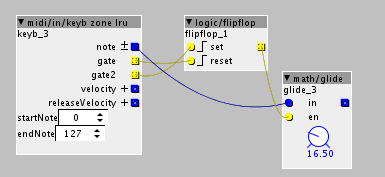That's a very good idea, that I haven't put into practice yet, but I'll do it very soon (for the old ones), and from now on with all new patches.
Thanks
General Midi collaborative library
Pad sound made with a 3 wavetable oscillators + adsr on each into a LP filter, per voice
You need to have this wave table I created for it
Big128_1024.raw
You can make a million other sounds by tweaking this patch
8 voices polyphonic
089-Pad 1-mtyas.axp (49.4 KB)
A FM (or phase modulation) Timpani patch
8 voices polyphonic
048-Timpani-mtyas.axp (21.0 KB)
A track done by using most of the last made sounds, very little processing (a bit of eq and a big Plate reverb on Aux).
Axoloti is really good at producing FM sounds (good old DX years all over again).
An accordion sound
7 voices polyphonic
022-Accordion-mtyas.axp (28.8 KB)
I used this sound, converted into a MPE instrument and with a big delay, for this video (played using a striso board and one axoloti)
A Church Organ Patch
Paraphonic with built-in church reverb.
Available in the library:
Library/community/tiar/GM/020-ChurchOrgan-tiar.axp (26.9 KB)
"fb" controls the brilliance.
0 for a dull organ sound.
45 is optimal.
Here is a Dark Strings Patch
85 note paraphonic with stereo vib/chorus.
The modulation wheel introduces octave doubling
Available in the library:
Library/community/tiar/GM/052-Synth-Strings-2-tiar.axp
Basic and barbaric test of paraphony:
A western movie camp fire by night.
Library/community/tiar/GM/023-Harmonica-tiar.axp
- 3 octave paraphonic
- Aftertouch sensitive
- The modulation wheel controls the echo/delay
Simply play parallel thirds to get the wild west spirit.
Thanks @SmashedTransistors for these great patches, they sound very nice.
I was hoping to easily add pitch bend to them (for my own usage) but I can't see a way my limited brain can do it.
Keep up the great work (I like the saxophone too  )
)
i don't think pitchbend will be easy to add since these patches use a fixed oscillator bank...
Most of the original string machines used a single HF oscillator and frequency and octave dividers.
Oscillators - in the oscillator banks i coded at the moment - are as easily modulable as any other oscillators.
I already added vibrato inputs for small (multiplicative linear: " * (1+epsilon) " ) frequency deviations (see the Harmonica patch).
I can make up a solution for larger (exponential) modulations and add an input for that.
Hi @mtyas,
I added +-12 semitone pitch bend to Library/community/tiar/strings/052-Synth-Strings-2-tiar.axp
Pitch bend on chords is evil 
Library/community/tiar/GM/031-Distortion-Guitar-tiar.axp
(beware of sound level)
I started this one to test the oversampling / downsampling / antialiasing objects I am developing.
This is a polyphonic patch that uses a common distortion, so the resulting sound mostly depends on the frequency ratios. 4th, 5th and 8ves sound smooth, other ratios will sound harsher.
- The pitch bend is +- one octave
- the modulation wheel induces vibrato
- the aftertouch controls the distortion (gains and cutoff/res of intermediary filter).
The distortion is x2 oversampled. It is based on the classic scheme: sat -> high pass -> sat
The saturations are anti aliased soft clippers (differentiated polynomials and x2 oversampled).
I added a stereotypical ping pong delay.
Library/community/tiar/GM/040-Synth-Bass-2-tiar.axp
A mono synth bass reminiscent of the late 70s.
great! for typical glide and portamento bass synth stuff i would rather use something like this at the input:

then feed your adsr from gate2 to only retrigger on non-legato notes if you so wish 
Polyphonic aftertouch
